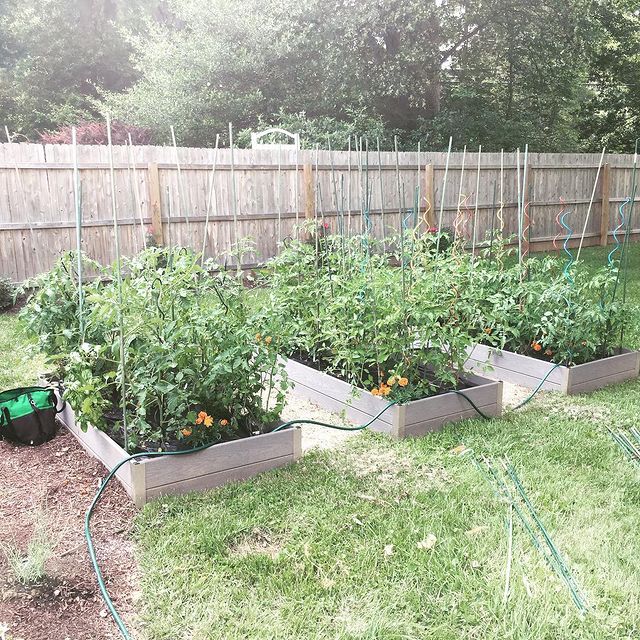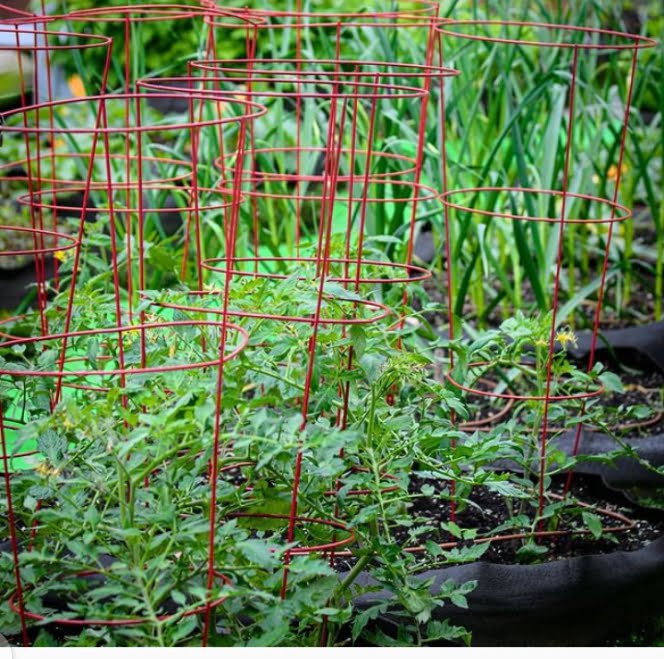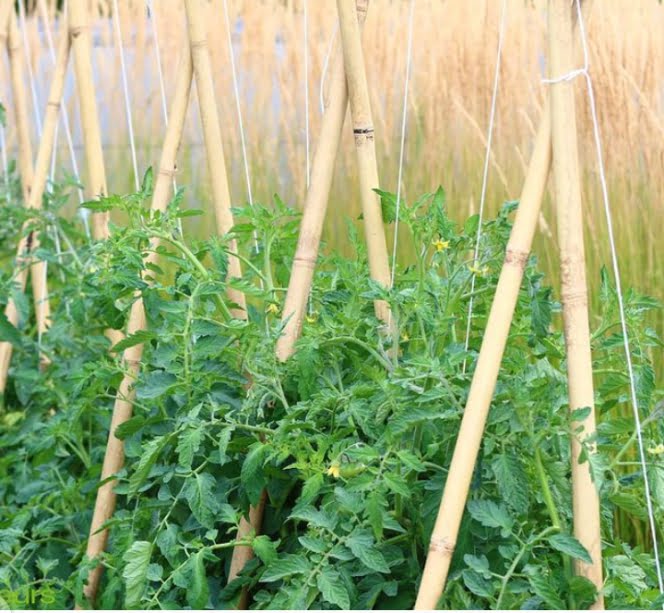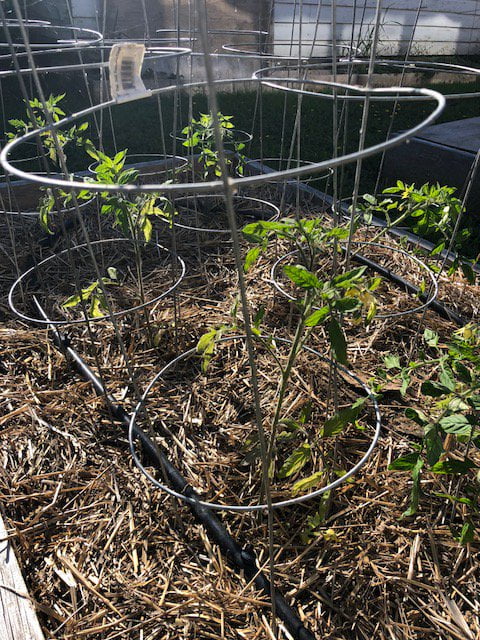Growing big, beautiful tomatoes starts with proper support – but should you stake them or use cages? Deciding between staking or caging tomato plants depends on your goals, space, and effort. Read on to learn the pros and cons of each method.
Juicy, vine-ripened tomatoes are a prime source of garden pride and summer flavor. However, their vines can sprawl up to 6 feet long, with fruit weighing on fragile branches. Securing plants with stakes or cages serves several key purposes:
- Prevents tomatoes from dropping onto soil and rotting
- Allows air circulation to lower disease risk
- Optimizes sunlight exposure for even ripening
- Makes picking easier without tangled, leaning plants
- Redirects energy toward fruit instead of excessive foliage
But is staking or caging tomato plants the better choice? We’ll compare the two techniques so you can decide what suits your needs.
Table of Contents
Staking Tomato Plants: The Traditional Method

For generations, gardeners have secured tomato plants using tall stakes and plant ties. Here’s an overview:
- Materials needed: wooden or metal stakes (at least 6 ft tall), plant ties/twist ties, pruning shears
- Set stakes 2 ft into the ground within a few inches of the plant. Drive stakes into the soil firmly so they won’t wiggle or fall over.
- Begin tying main stems to stakes when plants are 6-8 inches tall. Use soft plant ties (like plastic twist ties) to avoid damaging stems.
- Tie vines every 8-12 inches as they continue growing, leaving some slack in the ties to allow winding. Adjust ties as needed to prevent girdling.
- Prune off all suckers (branching shoots) that form in leaf joints between stem and main branches. This focuses growth upward on the main stem.
- As fruits form, side shoots will develop into clusters. Tie these trusses/clusters to horizontal supports (string, twine, wire) extending from stakes to keep weight off vertical stems.
- Staking supports heavy vines and fruit loads, prevents damage from ground contact, and makes harvesting easier by keeping fruits off the soil. Provides good airflow to reduce disease problems.
Benefits of Staking:
- Staking tomatoes maximizes plant height and yields
- Allows close planting in rows or beds
- Best support for large, indeterminate varieties
- Very sturdy in windy conditions
- Easiest access for pruning and picking tomatoes
Downsides of Staking:
- Time-consuming installation and plant tying
- Can still require extensive pruning
- Stakes often pulled up at season end
- Not suitable for short, bushy varieties
- Plants can outgrow stakes in peak summer
Overall, staking is ideal for gardeners growing indeterminate tomatoes in spacious raised beds who don’t mind the setup work. But for small-space or low-maintenance growers, cages offer an appealing alternative.
Caging Tomato Plants: The Low-Fuss Method

Tomato cages are cylindrical or cone-shaped wire frames that surround plants, providing flexible support:
- Set cages over plants and push bottom 2 inches into soil
- Choose 18-inch minimum diameter for room to grow
- Use 1-2 foot tall cages for bush types, 4-6 foot for indeterminate
- No tying required – plants grow through cage openings
Benefits of Caging:
- Very low maintenance once installed
- Allows close planting like stakes
- Adapts easily to different vine sizes
- Stores easily during winter months
- Less damage to plants compared to tying
Downsides of Caging:
- Can compress or flatten plants if too small
- Watering and pruning is more difficult
- Plants may outgrow cages during peak season
- Not as sturdy in high winds as staked plants
For gardeners short on time or wanting a low-fuss option, cages are the way to go. The flexibility suits both sprawling indeterminate and compact bush tomato varieties.
Key Considerations For Staking Or Caging Tomato Plants
Deciding Between Stakes or Cages for Tomato Plants
When it comes to supporting tomato plants, the two main options are staking with poles or trellising with cages. Each method has pros and cons to consider before deciding which works best for your garden situation.
Planting Style Compatibility
- Stakes – Require enough space between plants, at least 24-36 inches apart, to allow stakes to be positioned between rows. Staking works best for traditional rows spaced well apart.
- Cages – More adaptable to different planting configurations. Can be used effectively even when growing tomatoes in raised beds, containers, or more densely planted areas. Cages simply slip over individual plants.
Tomato Variety Suitability
- Stakes – Best for supporting tall, sprawling indeterminate tomato varieties that grow over 6 feet tall. Sturdy stakes prevent floppy, spreading vines.
- Cages – Ideal for shorter determinate or “bush” tomato varieties under 4 feet tall. Also suitable for dwarf tomato plants in containers. Cages keep these more compact plants tidy.
Wind and Weather Resistance
- Stakes – Can lever tomato plants out of the ground if not anchored very securely. Staking requires pounding stakes at least 12-18 inches into the ground. Individual tied vines are also more susceptible to wind damage.
- Cages – Tend to anchor and protect tomato plants better in windy conditions. The full cage structure surrounds plants rather than one side support. Choose heavy, durable cages that won’t blow over.
Installation Effort and Convenience
- Stakes – Require more advance work, takes more time and labor to pound stakes deeply into soil in properly spaced rows before planting.
- Cages – Very quick and easy to install. Simply place pre-assembled cages over transplants at planting time or slip around existing plants.
Ongoing Maintenance Needs
- Stakes – Must tie up vines frequently through the season to train them vertically along stakes. This takes more time and attention. Plants can outgrow single stakes.
- Cages – Do not require any tying up after installed. Check occasionally to push stray vines back through cage openings. Cages are largely “set and forget.”
Plant Spacing Flexibility
- Stakes – Allow tighter row spacing, with plants as close as 18-24 inches apart. Stakes take up less space between plants.
- Cages – Require wider spacing, up to 3-4 feet apart, to allow cage openings to overlap. Cages take up more square footage.
Added Benefits
- Stakes – Allow leaves to receive sun from all directions for maximum photosynthesis. Just avoid over-crowding.
- Cages – Protect fruits and foliage from hail damage. Cages also keep ripening fruits cleaner and off the ground. An added barrier from pests.
There are pros and cons to both staking or caging tomato plants. Selecting the best support method depends largely on the type of tomatoes you’re growing and your personal gardening style.
Getting the Best Results From Stakes vs. Cages
Follow these tips to maximize success with your chosen tomato support system:
Staking tips:

- Stake thickness – Use hardwood stakes that are at least 1-2 inches wide to handle heavier tomato varieties. Thin bamboo stakes often bend and can snap from weight.
- Stake height – Stakes should be 5-7 feet tall depending on tomato variety height. This provides support for the entire plant through harvest.
- Staking depth – Pound stakes into soil at least 12-18 inches deep using a post pounder tool. This anchors stakes firmly to resist wind leverage on plant and fruits.
- Tie placement – Use soft twist ties or fabric strips to tie main stem to stake every 8-12 inches up the stake. This prevents stem abrasion and provides continuous support.
- Horizontal supports – Add shorter cross sticks or procure special horizontal support bars to attach to stakes at lower trusses. This prevents flopping branches.
- End-post trellising – Install a T-post at end of rows and run strings between for added stability. Weave plants through strings as they grow taller.
Caging tips:

- Cage durability – Opt for heavy-duty wire cages rather than flimsy thin mesh that will bend. Taller cages with 3-4 support hoops are most durable.
- Cage installation – Push cages into soil at least 2 inches deep so they don’t shift or blow over. Or use ground posts to secure cages.
- Cage capacity – Match cage size to tomato variety’s mature height and width. Too small cages restrict plants. Too large is not as stable.
- Placement – Install cages immediately after transplanting young plants or slipping around established plants. Don’t wait until later.
- Plant weaving – Gently weave vines through cages rather than letting them grow outside. This keeps fruits protected inside cage.
- Attachment accessories – Use cage zip ties or Velcro plant ties to attach and train main stems onto cage wires to provide extra support.
Follow these best practices during setup and care to get the most out of your tomato stake or cage system all season long.
The Bottom Line
With the right setup and care, both staking and caging reliably support tomato plants for optimum growth and fruit production. Staking is ideal for gardeners focused on maximizing height and yields, while flexible cages offer an easy-care option. Consider your goals, space, and commitment level when deciding between these two effective tomato support systems. Regardless of your choice, proper staking or caging will reward you with a bountiful summer harvest!
